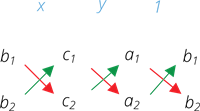PDF chapter test TRY NOW
Let us consider two linear equations.
a_1x+b_1y+c_1 = 0 ----- (1)
a_2x+b_2y+c_2 = 0 ----- (2)
Where \frac{a_1}{a_2}\neq \frac{b_1}{b_2}.
Now, let us solve these two equations.
Multiply equation (1) by b_2 and equation (2) by b_1.
Thus, we have:
x(a_1b_2-a_2b_1) =b_1c_2-b_2c_1
x=\frac{(b_1c_2-b_2c_1)}{(a_1b_2-a_2b_1)}
Similarly, let us multiply equation (1) by a_2 and equation (2) by a_1.
Thus, we have:
y(b_1a_2-b_2a_1) =c_2a_1-c_1a_2
y=\frac{(c_2a_1-c_1a_2)}{(b_1a_2-b_2a_1)}
Therefore, the solution to the given system of linear equations is
x = \frac{(b_1c_2-b_2c_1)}{(a_1b_2-a_2b_1)} and y = \frac{(c_1a_2-c_2a_1)}{(b_1a_2-b_2a_1)}.
The other way to represent the solution is given by:
\frac{x}{b_1c_2-b_2c_1} = \frac{y}{c_1a_2-c_2a_1} = \frac{1}{a_1b_2-a_2b_1}
It can easily remembered as:

Let us consider an example to understand the concept clearly.
Example:
Solve the simultaneous linear equations 2x+y = 8 and x+2y = 10 by cross multiplication method.
Solution:
Let us write the given equations in the form of ax+by+c = 0.
2x+y-8 = 0 ---- (1)
x+2y-10 = 0 ---- (2)
Now, let us write the coefficients in the form of

Thus, we have:

\frac{x}{(1)(-10)-(2)(-8)}=\frac{y}{(-8)(1)-(-10)(2)} = \frac{1}{(2)(2)-(1)(1)}
\frac{x}{-10-(-16)} = \frac{y}{-8-(-20)} = \frac{1}{4-1}
\frac{x}{-10+16} = \frac{y}{-8+20}=\frac{1}{3}
\frac{x}{6} = \frac{y}{12}=\frac{1}{3}
\frac{x}{6} = \frac{1}{3} and \frac{y}{12} = \frac{1}{3}
x = \frac{6}{3} and y = \frac{12}{3}
x = 2 and y = 4
Therefore, the solution is x = 2 and y = 4.
